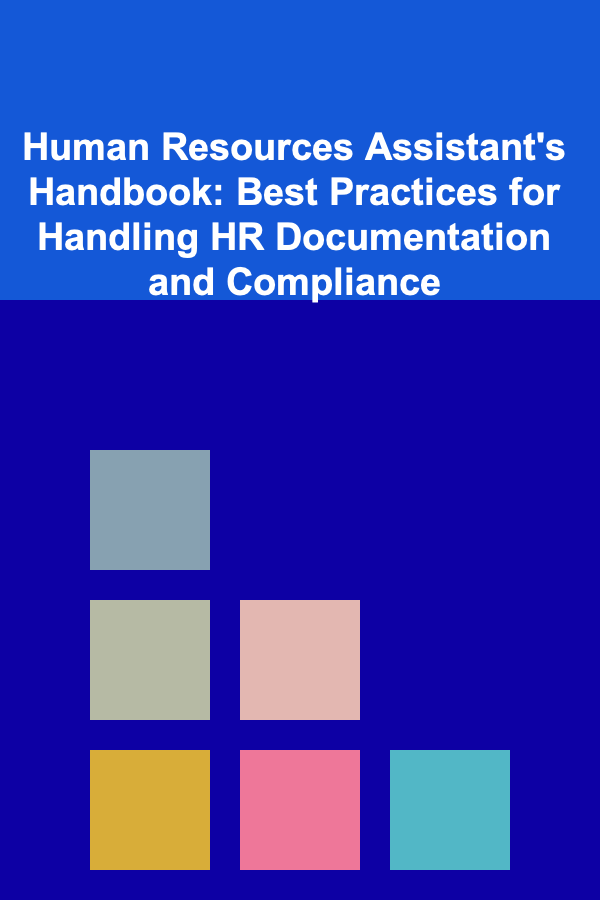
How to Design a Checklist for Re-engaging Inactive Email Subscribers
ebook include PDF & Audio bundle (Micro Guide)
$12.99$10.99
Limited Time Offer! Order within the next:

Email marketing is one of the most powerful tools in any marketer's arsenal. However, the effectiveness of email campaigns can dwindle if subscribers become inactive or stop engaging with your content. Re-engaging inactive email subscribers is critical to maintaining a healthy email list and maximizing the potential of your campaigns. A systematic approach is essential for this process, and a well-designed checklist can help guide you through the necessary steps.
In this article, we will discuss how to design an actionable checklist for re-engaging inactive email subscribers, ensuring you have a clear, organized process for bringing them back into the fold.
Define Your Inactive Subscriber Criteria
Before attempting to re-engage inactive subscribers, it's crucial to define what "inactive" means for your specific audience. Different businesses may have varying definitions based on their goals and the nature of their email campaigns. Generally, an inactive subscriber is someone who hasn't opened or interacted with your emails over a specific period.
Actions:
- Determine the Time Frame: A common approach is to consider subscribers inactive if they haven't opened an email in 3-6 months. However, this may vary depending on your industry and email frequency.
- Track Email Engagement: Set up tracking for email opens, clicks, and conversions. Analyzing engagement patterns will help you identify which subscribers are at risk of becoming inactive.
- Segment Your List: Use your email marketing platform's segmentation tools to separate inactive subscribers based on their behavior. Create a distinct group for re-engagement efforts.
Tip:
- Consider a sliding scale for activity level (e.g., opens emails but doesn't click, clicks but doesn't convert) to tailor your strategy more specifically.
Audit Your Current Email Campaigns
Before diving into re-engagement tactics, it's important to assess the quality and relevance of your current email campaigns. If your content or delivery method isn't resonating with subscribers, no re-engagement effort will succeed.
Actions:
- Review Subject Lines: The subject line is the first thing a subscriber sees. Make sure yours are clear, compelling, and relevant. Use A/B testing to compare different subject lines and optimize engagement.
- Examine Email Content: Is your email content providing value to your subscribers? Check if it's overly promotional, irrelevant, or too infrequent.
- Optimize Send Times: Test different send times to see when your subscribers are most likely to engage with your emails. You might be sending emails at times when they're less likely to be seen.
- Check Mobile Optimization: Ensure your emails are responsive on mobile devices. A significant portion of users opens emails on their phones, and if the email isn't mobile-friendly, they might ignore it.
Tip:
- Keep an eye on your unsubscribe rates, as they may offer insights into why people are disengaging with your emails in the first place.
Craft a Targeted Re-engagement Email Series
Once you've audited your current campaigns, it's time to design a specific re-engagement email sequence. A series of well-crafted emails will gradually warm up inactive subscribers, rather than bombarding them with aggressive messaging all at once.
Actions:
- Start with a Compelling Subject Line: Capture attention from the get-go. Use curiosity, personalization, or urgency in your subject lines to intrigue subscribers.
- Personalize the Email Content: Use the subscriber's name and past behaviors to create personalized, relevant offers or content. For instance, if a subscriber previously engaged with a particular product category, remind them of those items with special offers.
- Provide Incentives: Offer an incentive to bring back inactive subscribers, such as exclusive discounts, free trials, or access to premium content.
- Use a Friendly and Empathetic Tone: Instead of sounding like you're demanding something from them, express understanding. For example, "We miss you" or "We'd love to hear what's been keeping you away" creates a more approachable message.
- Include Clear Calls-to-Action (CTAs): Don't leave subscribers wondering what to do next. Each email should have a clear, easy-to-follow CTA.
Tip:
- Create a sense of urgency or scarcity by including limited-time offers. Phrases like "Only available for the next 48 hours" can prompt subscribers to act quickly.
Segment Your Re-engagement Campaigns
Not all inactive subscribers are the same. Some may have been dormant for a short time, while others may have stopped engaging months ago. Segment your audience based on their inactivity period and tailor your messaging accordingly.
Actions:
- Short-Term Inactive Subscribers (1-3 months): For subscribers who've only recently stopped engaging, send emails reminding them of your value proposition. Offer a simple incentive like a discount or access to new content.
- Long-Term Inactive Subscribers (3+ months): These subscribers may require more effort to regain trust. Try sending them a series of emails with increasingly appealing offers. Ask them for feedback on why they stopped engaging and invite them back with an exciting promotion or announcement.
Tip:
- Consider sending a re-engagement survey to gather insights from long-term inactive subscribers. This can help refine your approach and learn what might have caused their disinterest.
Utilize Automation to Maximize Efficiency
Re-engagement campaigns can be time-consuming, especially when dealing with a large email list. Setting up automated workflows will allow you to re-engage subscribers without manual intervention.
Actions:
- Set up Drip Campaigns: Automate a sequence of emails that gradually re-engage inactive subscribers over a series of days or weeks. This could be a combination of reminder emails, value-driven content, and incentives.
- Trigger-Based Automation: Set up triggers based on subscriber behavior (or lack thereof). For example, if a subscriber hasn't opened your last 3 emails, trigger an automated re-engagement campaign.
Tip:
- Monitor engagement closely and adjust automation flows as needed. If a subscriber engages with the re-engagement emails, remove them from the campaign to prevent oversaturation.
Optimize for Deliverability and Avoid Spam Filters
A high deliverability rate is crucial to the success of any email marketing campaign, including re-engagement efforts. Even if your emails are compelling, they won't make an impact if they end up in the spam folder.
Actions:
- Clean Your Email List Regularly: Remove invalid or bouncing email addresses from your list. This will help maintain a good sender reputation and improve deliverability.
- Monitor Engagement Metrics: Pay attention to open rates, click rates, and bounce rates to gauge your email deliverability and optimize your campaigns accordingly.
- Use Double Opt-In: Ensure that subscribers confirm their subscription to avoid sending emails to fake or inactive addresses. This will help your overall list hygiene.
- Avoid Spammy Language: Steer clear of overuse of words like "free," "limited time," and "act now," which can trigger spam filters.
Tip:
- Consider using a tool like an email deliverability monitor to help you keep track of any issues with your emails landing in spam folders.
Measure and Optimize Your Re-engagement Campaigns
After launching your re-engagement campaign, it's essential to track performance and continuously optimize. Re-engagement is not a one-time effort; it's an ongoing process of testing, learning, and refining.
Actions:
- Track Key Metrics: Monitor open rates, click-through rates, conversion rates, and unsubscribe rates to measure the effectiveness of your campaign.
- A/B Test Subject Lines and Offers: Continuously test different subject lines, content, and offers to see which resonate best with your audience.
- Request Feedback: If you have a particularly low re-engagement rate, consider asking your subscribers directly what would encourage them to return.
Tip:
- Use the data you collect to tweak and optimize future re-engagement efforts. Pay attention to patterns in subscriber behavior and continually adapt your strategy based on what works.
Set Clear Expectations for Re-engagement Campaigns
Not every inactive subscriber will re-engage, and that's okay. Ensure that your re-engagement efforts have a clear endpoint to prevent wasting resources on those who will not convert.
Actions:
- Set a Timeline: Create a timeline for re-engagement and let subscribers know that after a certain point, they will be removed from your email list. A message like "We'll miss you, but if we don't hear from you by [date], we'll say goodbye" can create a sense of urgency.
- Remove Non-Engagers: After exhausting your re-engagement efforts, clean your list by removing subscribers who haven't interacted. This will help improve your overall list quality and email metrics.
Tip:
- While you should give inactive subscribers a final chance to engage, it's important not to let them continue receiving emails indefinitely if they show no interest.
By following these steps and designing a comprehensive re-engagement checklist, you can revive dormant subscribers and re-establish valuable relationships. Remember, the key to success is personalization, timing, and a focus on delivering value. Not all inactive subscribers will return, but with a targeted approach, you'll maximize your chances of re-engagement and increase the long-term health of your email list.
Reading More From Our Other Websites
- [Organization Tip 101] How to Create a Welcome Area for New Volunteers
- [Reading Habit Tip 101] From Page to Pronunciation: Turning Reading Habits into Vocabulary Wins
- [Home Rental Property 101] How to Properly Insure a Rental Property with a Basement: Protecting Your Investment
- [Home Renovating 101] How to Choose and Install New Light Fixtures Safely: A Step-by-Step Guide
- [Home Storage Solution 101] How to Organize Your Bathroom with Minimalistic Storage Solutions
- [Personal Investment 101] How to Earn Money with AI Tools Powered by Deep Learning
- [Organization Tip 101] How to Use Trunks and Chests for Vintage Storage
- [Home Pet Care 101] How to Choose Pet Bedding That Promotes Healthy Sleep and Is Easy to Clean for Busy Owners
- [Star Gazing Tip 101] Astronomy 101 for Lovers: Must-Know Tips for a Successful Star-Gazing Date
- [Personal Financial Planning 101] How to Create a Net Worth Statement: How to Create a Net Worth Statement That Reveals Hidden Opportunities for Growth

How to Keep Your Home Safe with Regular Security System Maintenance
Read More
How to Plan a Backyard Campfire Party for a Cozy Night In
Read More
Human Resources Assistant's Handbook: Best Practices for Handling HR Documentation and Compliance
Read More
How to Give Powerful Presentations as a Leader
Read More
10 Tips for Improving Inventory Management as a Pharmacy Technician
Read More
10 Tips for Prioritizing Features with Confidence
Read MoreOther Products

How to Keep Your Home Safe with Regular Security System Maintenance
Read More
How to Plan a Backyard Campfire Party for a Cozy Night In
Read More
Human Resources Assistant's Handbook: Best Practices for Handling HR Documentation and Compliance
Read More
How to Give Powerful Presentations as a Leader
Read More
10 Tips for Improving Inventory Management as a Pharmacy Technician
Read More